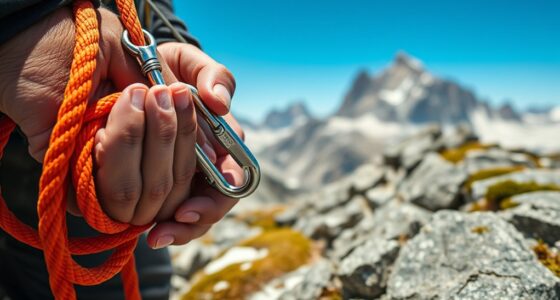To master road climbing, focus on smart gear selection, shifting to lower gears early to maintain cadence and conserve energy. Keep a steady effort, adjusting your pace as needed, and stay within a cadence of 70-90 RPM for efficiency. Maintain relaxed shoulders, smooth pedal strokes, and good posture to reduce fatigue. With consistent practice, these strategies become second nature, making climbs more manageable—and if you keep exploring, you’ll discover even more ways to improve.
Key Takeaways
- Shift to lower gears early to maintain cadence and prevent muscle burnout during climbs.
- Pace yourself steadily, avoiding all-out efforts at the start for sustainable energy use.
- Use monitoring devices like heart rate monitors and power meters to manage effort and optimize pacing.
- Maintain relaxed shoulders and steady posture to reduce energy waste and improve endurance.
- Practice proper technique and gear selection regularly to develop confidence and climbing efficiency.

Climbing hills on the road can be challenging, but mastering the right techniques makes it much easier. One of the most crucial aspects is gear selection. When approaching a hill, you want to shift into a gear that allows you to maintain a steady cadence without straining your legs. Typically, this means shifting to a lower gear before you reach the incline rather than waiting until you’re already struggling. Proper gear choice helps conserve energy and keeps your muscles from burning out too quickly. It also enables you to keep a consistent rhythm, which is essential for efficient climbing. Practice shifting smoothly so that your transitions are seamless, preventing loss of momentum and reducing fatigue.
Along with gear selection, pacing strategies play a pivotal role in conquering hills effectively. Instead of going all-out at the start, aim for a steady, sustainable effort. Pacing means managing your energy so you can maintain your effort throughout the climb without exhausting yourself prematurely. A good rule of thumb is to start the hill slightly below your maximum effort and then adjust as you go. If you feel yourself slowing down, ease up a bit; if you’re feeling strong, you can gradually increase your effort. Keep your cadence consistent, around 70-90 revolutions per minute, to optimize efficiency and reduce muscle fatigue. Using a heart rate monitor or power meter can help you stay within your ideal intensity zone, ensuring you don’t push too hard early on and lose steam before reaching the summit.
In addition, it’s essential to stay relaxed and maintain good posture during the climb. Keep your upper body stable, shoulders relaxed, and avoid excessive rocking or tension, which wastes energy. Focus on smooth pedal strokes and maintaining a steady breathing pattern. As you approach the hill, anticipate the difficulty and mentally prepare yourself to stay disciplined with your effort. Remember, the key to successful hill climbing isn’t just brute strength but smart technique—selecting the right gear and pacing yourself properly can make all the difference. Developing proper technique and consistent practice will help you become more confident and efficient during climbs. With practice, these strategies will become second nature, allowing you to tackle hills more confidently and with less fatigue. Over time, you’ll find yourself climbing with greater efficiency, conserving energy for the descents or subsequent climbs. Mastering gear selection and pacing strategies transforms a formidable task into a manageable challenge, ultimately boosting your endurance and enjoyment on every ride.
Frequently Asked Questions
How Can I Improve My Confidence on Steep Climbs?
To boost your confidence on steep climbs, focus on mental preparation and visualize success. Before starting, remind yourself of your strengths and previous victories. Break the climb into smaller sections and celebrate each milestone. Maintain a positive mindset, breathe deeply, and stay relaxed. Visualizing yourself conquering the climb helps build mental resilience. With consistent practice and self-belief, you’ll find yourself climbing steeper hills with greater confidence.
What Gear Is Best for Different Road Gradients?
It’s no coincidence that your gear selection depends on terrain assessment. For steep gradients, you want a lower gear to maintain cadence without overexerting, while flatter sections let you shift to higher gears for speed. Always evaluate the road’s incline and surface before shifting, ensuring you’re in the right gear to optimize efficiency and comfort. Adapting your gear choices based on terrain helps you climb more smoothly and confidently.
How Should I Adjust My Breathing During Climbs?
You should focus on maintaining a steady breathing rhythm during climbs, ensuring you’re inhaling and exhaling smoothly. Try to breathe deeply through your nose or mouth, matching your breath to your pedaling cadence. When climbing, emphasize exhaling fully to release carbon dioxide and make room for fresh air. This helps keep your muscles supplied with oxygen, reducing fatigue and maintaining your energy throughout the ascent.
What Are Common Mistakes Beginners Make When Climbing?
Did you know that 65% of beginners struggle with gear selection during climbs? You often make mistakes like using the wrong gear, which hampers your technique refinement and causes fatigue. To improve, focus on smooth gear changes and maintaining a steady cadence. Avoid rushing your shifts and keep your body position optimized. Practicing these habits helps you climb more efficiently, conserving energy and reducing strain.
How Does Weather Affect Road Climbing Strategies?
Weather impact substantially influences your road climbing strategies. Rain, wind, or extreme temperatures can make climbs more challenging and dangerous. You should plan seasonal preparation accordingly, adjusting your pace and gear for conditions. In wet or icy weather, slow down and increase your grip to stay safe. Hot weather requires hydration and pacing, while colder conditions mean layered clothing. Adapting to weather ensures safer, more effective climbs year-round.
Conclusion
Mastering road climbing techniques is like reaching the summit of your own Everest; it’s a test of resilience, skill, and patience. Remember, every steep incline is an opportunity to channel your inner hero, much like Odysseus maneuvering treacherous waters. With dedication and practice, you’ll conquer those climbs with grace and confidence. Keep pushing forward—you’re forging your path, just as the great explorers dared to venture into the unknown.









